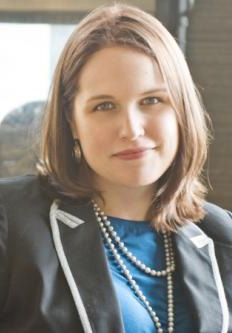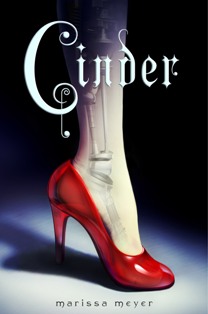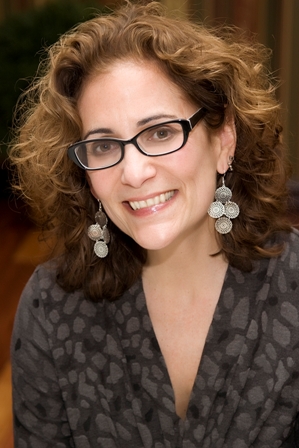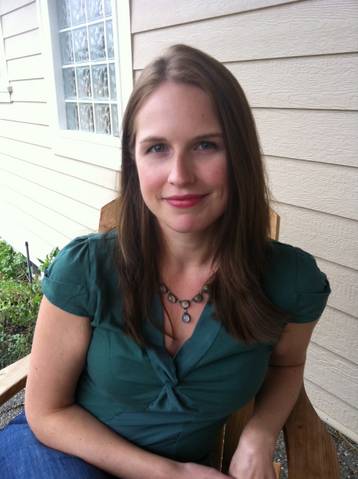 The heroine of Marissa Meyer's debut novel needs no fairy godmother. As New Beijing's best mechanic, Cinder earns her own keep and supports her adoptive family. "I have always seen Cinder as a self-reliant character," Meyer says. "I'm a fan of the original Cinderella, but one of my problems is that the girls are so dependent. I like girls who are courageous." Cinder fashions her own "coach" from a gasoline-powered car she discovers in the junkyard with the help of her right-hand android, Iko. Here the author discusses the seeds for her highly original retelling, and fan fiction as her writing lab.
The heroine of Marissa Meyer's debut novel needs no fairy godmother. As New Beijing's best mechanic, Cinder earns her own keep and supports her adoptive family. "I have always seen Cinder as a self-reliant character," Meyer says. "I'm a fan of the original Cinderella, but one of my problems is that the girls are so dependent. I like girls who are courageous." Cinder fashions her own "coach" from a gasoline-powered car she discovers in the junkyard with the help of her right-hand android, Iko. Here the author discusses the seeds for her highly original retelling, and fan fiction as her writing lab.
What inspired the story of Cinder?
It started with a writing contest for a short story. We had to include two items out of 10. I chose a fairy tale and to set it in the future, and wrote about a futuristic robot, Puss in Boots, a talking cat that found a poor girl and convinced her she was a princess. It was so fun to write that after I finished it, I thought I'd write a whole series of futuristic fairy tales. One night, drifting off to sleep, I got an image of Cinderella as a cyborg, and her foot was falling off.
Before this, you were writing fan fiction?
I wrote fan fiction for "Sailor Moon" [under the pen name Alicia Blade], which was a really popular anime series in the 1990s. It has six or seven series, but I always wrote from the first one, in which the male and female have secret identities. When they're superheroes, they love each other, but they couldn't stand each other when they were posing as their secret identities. I really enjoyed writing fan fiction, and met great friends. Three of them are my beta readers for Cinder. I know all my "Sailor Moon" fans will recognize elements of those stories in Cinder. In "Sailor Moon" there's also a moon kingdom and a lost princess, and I know they infiltrated my subconscious. Fan fiction is a great way to get your feet wet as a writer.
How did you come up with the idea of Cinder as a mechanic?
From the first draft, she had an innate ability with mechanics and understanding of how things work, and that's how she earned her keep with her stepmother. But a lot of her other awesome talents didn't develop until two or three drafts into it. After I'd written the first draft, it occurred to me that I had this cyborg character and hadn't developed her to her full extent. Her ability to detect lies, for example, wasn't originally part of her character.
With the tensions between Lunar society and Earth, inhabitants of both question what is good and what is evil. It's complicated, isn't it? Even stepmother Adri isn't all bad.
I don't think there's somebody who's all good or all bad. I think it's important to explore all the different levels in their characters. It's tempting to make someone all bad all the time. That's the easy way out, but I didn't want to do that with Adri or Queen Levana. Here you only see the evil side of the queen, but in future books readers will start to understand more where she's coming from also. That's a goal for me as a writer--to make the villains as real and interesting as the good guys are.
Will we get to see what Luna looks like?
Almost the entire fourth book will take place on Luna.
How did you come up with the plague, Letumosis?
That was one of my early ideas for Snow White. She has to wind up in a glass coffin. I knew she would go into a suspended animation phase, and it would be because of this disease. I need it for the fourth book to work, but it creates conflict from the very start.
And Queen Levana's glamour?
The glamour came about because of this idea of the evil queen in the fairy tales always being so vain. And in Snow White the stepmother tries to have her murdered because Snow White is more beautiful. Queen Levana is quite a bit older than our characters, so that's how the glamour got started.
Did you always know it would be four books? Or did that start to take shape as you wrote Cinder?
I knew it would be four books early on. I started by making a list of my favorite fairy tales--six or seven altogether. As I tried to fit them into a sci-fi genre, I thought, "Could these overlap? How could they tie together?" While I was doing this, I came up with the Queen Levana character. She quickly became the villain for all four. The way they'd tie together came to me pretty early on, and also how they'd overlap to make one continuous story.
Tell us about the other three books.
Book two is Scarlet, and it's based on Little Red Riding Hood. Book three is Cress, inspired by Rapunzel. And the fourth, Winter, is based on Snow White. We'll continue to follow Cinder as she puts together the pieces of her past and how to defeat Levana. They'll have separate, parallel story lines, and Cinder's path will cross with theirs. They'll form one group with a mission to defeat Queen Levana and stop the war.
At what stage did you begin submitting the manuscript for Cinder?
I had a detailed outline of the first three books before I started writing, and a vague idea of book four. I started writing the first three books back to back without pausing. When I first started querying agents, Cinder had been revised many times. But I was also on the third draft of the second book, and the second draft of the third book before I started submitting it to agents. I knew that, being a new author, it would be difficult to convince someone I could pull off four books in a series. That's part of the reason I was so neurotic about making sure I had so much finished.







 Once upon a time, Cinderella was a cyborg supporting herself and her adoptive family as a skilled mechanic in a plague-ridden future.
Once upon a time, Cinderella was a cyborg supporting herself and her adoptive family as a skilled mechanic in a plague-ridden future.
 The heroine of Marissa Meyer's debut novel needs no fairy godmother. As New Beijing's best mechanic, Cinder earns her own keep and supports her adoptive family. "I have always seen Cinder as a self-reliant character," Meyer says. "I'm a fan of the original Cinderella, but one of my problems is that the girls are so dependent. I like girls who are courageous." Cinder fashions her own "coach" from a gasoline-powered car she discovers in the junkyard with the help of her right-hand android, Iko. Here the author discusses the seeds for her highly original retelling, and fan fiction as her writing lab.
The heroine of Marissa Meyer's debut novel needs no fairy godmother. As New Beijing's best mechanic, Cinder earns her own keep and supports her adoptive family. "I have always seen Cinder as a self-reliant character," Meyer says. "I'm a fan of the original Cinderella, but one of my problems is that the girls are so dependent. I like girls who are courageous." Cinder fashions her own "coach" from a gasoline-powered car she discovers in the junkyard with the help of her right-hand android, Iko. Here the author discusses the seeds for her highly original retelling, and fan fiction as her writing lab. When Liz Szabla, editor-in-chief for Feiwel & Friends, saw the word "cyborg" in agent Jill Grinberg's pitch letter for Cinder, "I was all over it," Szabla said. "I hadn't heard or seen that word in anything to do with my work. It felt fresh." She also admitted to being a huge Terminator fan: "I kept it covered up because it felt nerdy to me," she said with a laugh. Her colleagues at Macmillan also quickly came on board. "There was something there for everybody," said Szabla. She felt that Cinder's strength has a lot to do with the book's appeal, too.
When Liz Szabla, editor-in-chief for Feiwel & Friends, saw the word "cyborg" in agent Jill Grinberg's pitch letter for Cinder, "I was all over it," Szabla said. "I hadn't heard or seen that word in anything to do with my work. It felt fresh." She also admitted to being a huge Terminator fan: "I kept it covered up because it felt nerdy to me," she said with a laugh. Her colleagues at Macmillan also quickly came on board. "There was something there for everybody," said Szabla. She felt that Cinder's strength has a lot to do with the book's appeal, too. On your nightstand now:
On your nightstand now: